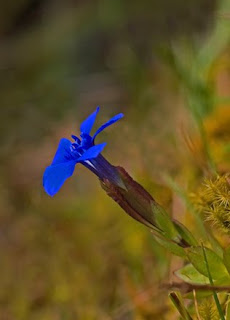
The Burren, in north County Clare, is a magical place. The region is dotted with Neolithic tombs, vast underground cave networks and a unique assemblage of plants and animals. This limestone Karst region was formed at the bottom of a warm, shallow sea at the end of the Lower Carboniferous period around 340 million years ago, the many marine fossils scattered throughout the rocks bearing witness to this. From a distance the Burren looks barren and lifeless, almost lunar in appearance. However, this could not be further from the truth as the region has an incredibly species rich flora, of international importance. But the real draw of the region is the shear abundance of flowering plants and the vast feast of colour. The Burren is renowned for its unique assemblages of rare plants – Arctic/Alpine plants (spring gentians, mountain avens), growing alongside plants normally found in the Mediterranean (maidenhair fern). In association with these rare plants are equally rare insects such as the transparent burnet, a day flying moth, hundreds of which can be seen in a single field.

Transparent Burnet (Zygaena purpuralis)

Spring Gentian (Gentiana verna)

Wood White (Leptidea sinapsis)

Small Blue (Cupido minimus)

Mountain Avens (Dryas octopetala)

Hoary Rockrose (Helianthemum canum)

Fly Orchid (Ophrys insectifera)

Dingy Skipper (Erynnis tages)

Cowslip (Primula veris)

Common Milkwort (Polygala vulgaris)

Bloody Crane's Bill (Geranium sanguineum)
I would be in seventh heaven in that place: it sounds fantastic and definitely somewhere to remember for when I get the chance to do some travelling. The flowers and insects are lovely.
ReplyDeleteI grew up not too far from the Burren, and it was a regular haunt, not only for the flowers and landscape but also for the ring forts and peregrines. Thanks for reminding me that it's about time that I made a trip back!
ReplyDeleteThanks Kerry and Mark. Not to mention the amazing cave systems with one of the longest caves and one of the biggest stalegtites in Europe.
ReplyDeleteThese are exactly the kinds of things I would like to see. What is the best time of year to visit.
ReplyDeleteSpring time is just magical in the Burren - the gentians are best in May. But any time during the summer you will not be disapointed with the stunning diversity and abundance of flowers and attendant insects.
ReplyDelete